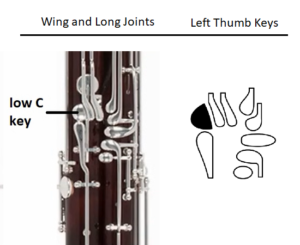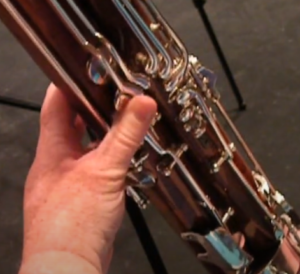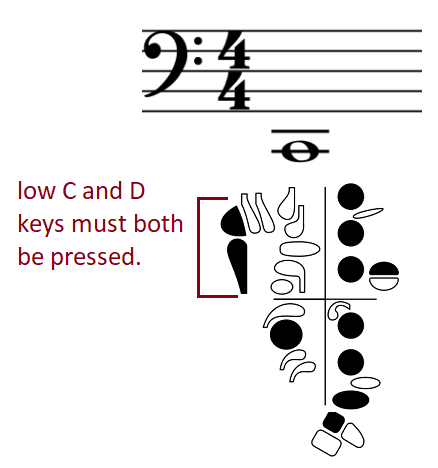The Low C key
The low C key is located on the long joint and is operated by the left thumb. The low C key is only used when playing below the bass staff.


Fingering
Your left thumb can no longer rest on the whisper key. The pad of your thumb should now rest on and press the low C key while the middle part of your thumb holds the low D key down.

NOTE:
The long joint mechanism is built so that the low C key connects to take the low D down with it. If your bassoon is in excellent adjustment, you should be able to press only the low C key and have the low D key go down too. However, that is rarely the case so you should plan to press both keys when possible.
Response
As long as your embouchure is soft and your lower jaw is relaxed (not pushing up on the reed), low C is one of the easier low notes.
If you have trouble getting low C to speak, try the suggestions below.
- Soaked reed
- “Hot Pizza” mouth
- Space the teeth
- Soft lips
- Low back of the tongue
- slow, warm, steady air
- firm articulation
- cover all tone holes completely
- low E key must press the whisper-key pad tightly against the bocal vent,
- Low F, E, D, and C keys must be pressed.
- Tip opening of the reed at least the thickness of a nickel. A reed that is too closed at the tip will not play low notes.

Intonation & Tone
Just like all of the other notes below the staff, low C tends to be sharp.
- soft lips
- open oral cavity
- space between the teeth
- back of the tongue low in the mouth
- Hot pizza mouth

TIPS: Keep your air steady and warm and make firm contact with your tongue against the reed when articulating in the low register.





Feedback/Errata